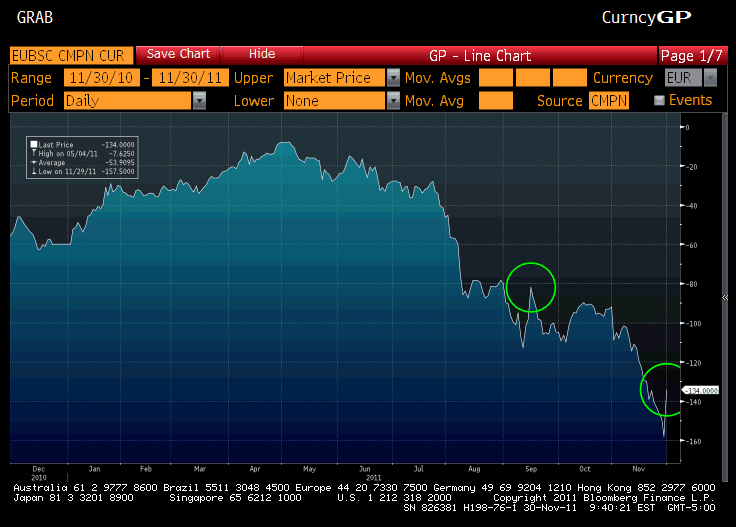Euro Basis Swap
So the Euro Basis Swap is once again a topic of conversation.
It was certainly on the radar screen of the bears as one of the rates that was not responding to the “Grand Plan” or other policy actions.
On September 15th, the first attempt at global co-ordination to bring the rate down was done. They put in place swap lines at OIS + 100 bps back then. The basis swap reversed that gain and got worse with the market into the end of September and early October. It participated in the October rally, but never got back to levels of September 15th, and started fading with the Grand Plan.
Many investors view this swap as an indicator of how difficult it is for European banks to fund in dollars. The basis swap can move around for many reasons, but there is good reason to believe it is an indicator of how difficult it is for European banks to fund their US businesses.
In normal times, European banks borrow in dollars to fund their US positions. That makes sense. As the banks face pressure on their USD funding rates, they have two choices, they can either pay up to get $’s directly, or they can borrow at home in euro’s and “swap” it into dollars. The basic premise is that foreign banks have more ability to raise money in their home countries or through their own central banks at times of stress. As they get shut out of borrowing directly in dollars they rely more and more on funding in their domestic market. US Banks may be scared to lend to French banks, but French institutions and individuals are far less likely to be as concerned. The borrow at home and swap it into dollars. That drives the basis swap more negative. Although that is only one of the explanations of the moves in the EUR basis swap, it is a reasonable way to look at the market.
To the extent that is why the rates were moving, it is clear why the central banks wanted to intervene. It doesn’t cost them anything to do and it provides the banks with a chance to earn more positive carry. By making such big globally coordinated announcements, it probably makes it easier for banks to shed the stigma of using the facility and can bring their cost of funds lower.
In the end, does it change the need to shed assets? No. Does it print money? No. Does it virtually ensure an ECB rate cut? Yes.
All this is being done to support the banks and their ability to function and in theory to lend. I think it will be successful in supporting bank credit spreads (this and other statements and actions point to senior unsecured debt as being protected). I doubt it encourages the banks to lend or to retain assets rather than continuing to deleverage. In which case it will be a policy disappointment.
Will any of this come at a cost? Will there be renewed pressure for banks to forgive sovereign debt? With public opinion so heavily against banks, does all of this help for banks really still come without a cost to them? Politically there is a lot of support to make banks take some pain. The focus of that pain is becoming more narrow – stocks and sub debt at risk, short-term unsecured debt and depositors safe. From the banking side, I think JPM is the best prepared to take advantage of any situation that puts renewed pressure on European banks to negotiate sovereign debt forgiveness, with DB best positioned in Europe (Ackerman has seemed the least scared of the problems for the past few months and stepped out of the IIF led negotiations). GS could do well, but they have become so demonized by the public that I doubt they will be able to take full advantage of any situation.
Like some other recent policy announcements (new IMF fast lending to otherwise good countries that are affected by contagion) this policy is okay in normal times, but is even more important and useful if the ECB decides not to print and the IMF doesn’t step up to provide massive money without demanding some restructuring in addition to austerity.

